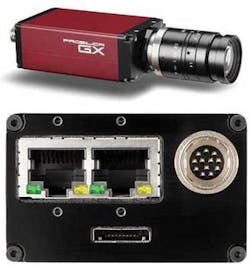GIGABIT ETHERNET CAMERAS: Gigabit Ethernet cameras go on show at VISION
With hopes of a faster than 800-Mbit/s FireWire interface waning, camera vendors wishing to support the latest high-speed CCD and CMOS imagers are moving to Gigabit Ethernet at a rapid pace.
Nowhere was this more apparent than at VISION, held in Stuttgart, Germany, Nov. 3–5, 2009, where many companies introduced GigE-based products. There, vendors such as Sony Electronics (Park Ridge, NJ, USA; www.sony.com/videocameras), Basler Vision Technologies (Ahrensburg, Germany; www.baslerweb.com), and Allied Vision Technologies (Stadtroda, Germany; www.alliedvisiontec.com) all introduced new CCD cameras based around GigE.
Despite featuring the same interface, the resolutions and capabilities offered by each vendor were far from similar. Sony, for example, displayed four different cameras in its XCG series that featured different sensors and resolutions ranging from VGA to 5 Mpixels. These cameras vary from the XCG-V60E, a VGA camera that uses a 1/3-in. imager running at 90 frames/s, to the XCG-5005E, a 5-Mpixel, 2/3-in. imager running at 15 frames/s.
For system integrators wishing to incorporate these cameras, a separate power cable must be used. To eliminate this cable, Basler announced its line of GigE-based ace cameras that support power over Ethernet. Like Sony, Basler introduced four new models ranging from the acA640-100, a 640 × 480-pixel, 100 frames/s camera to the acA1600-20, a 1628 × 1236-pixel camera capable of running at 20 frames/s.
The introduction of megapixel sensors operating at even faster frame rates has in the past limited the use of both FireWire and GigE interfaces. To overcome these limitations using existing standards, manufacturers are developing novel workarounds that include dual camera interfaces.
In January 2009, for example, Point Grey Research (Vancouver, BC, Canada; www.ptgrey.com) developed a dual-bus FireWire architecture and a Grasshopper camera that allows the Kodak quad-output 1920 × 1080-pixel CCD to run at 64 frames/s (see “Extendable Standards,” Vision Systems Design, January 2009).
Now, a similar concept has been introduced by Allied Vision Technologies. At VISION, the company introduced four new GigE cameras: the Prosilica GX1050, a 1-Mpixel camera that runs at 120 frames/s; the GX1660 and GX 1910 that incorporate a 2-Mpixel CCD running at 60 frames/s; and the GX3300 with an 8-Mpixel imager running at 15 frames/s.
With output data rates far exceeding the maximum 1-Gbit/s maximum throughput of the GigE standard, Allied Vision Technologies has equipped these cameras with two GigE ports and uses the link aggregation standard defined in IEEE standard 802.3ad to combine both physical GigE links into a single logical link (see figure). This technique, often used in networking systems, provides two advantages: It increases the effective bandwidth of the system and provides redundancy for GigE-based systems.
However, because link aggregation does not modify the 802.3 Ethernet frame structure, it is transparent to upper-layer-level protocols, guaranteeing compatibility with the exiting GigE Vision standard.
Despite it being extensible, it remains to be seen whether other manufacturers will adopt this approach since dual-link configurations alone require dual GigE interface adapters and two cables for the camera-to-computer interface. Like the dual FireWire interface developed by Point Grey, link aggregation may be just a stepping stone toward a faster, perhaps optical, interface.

